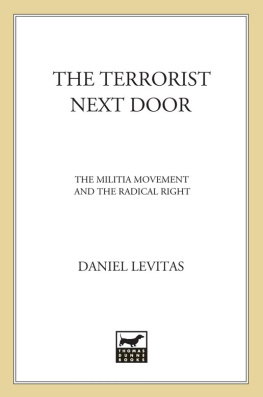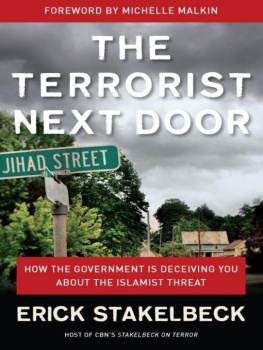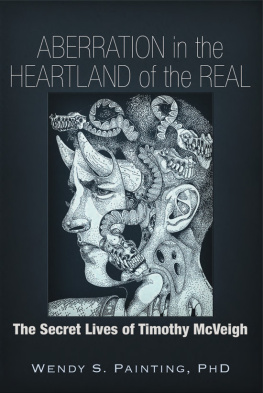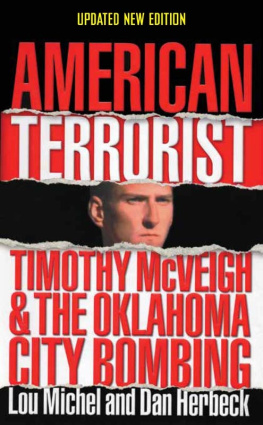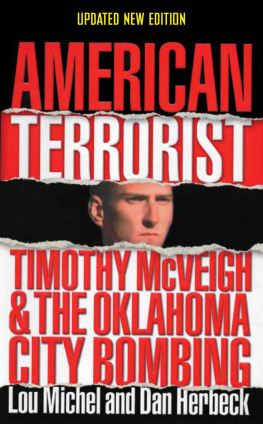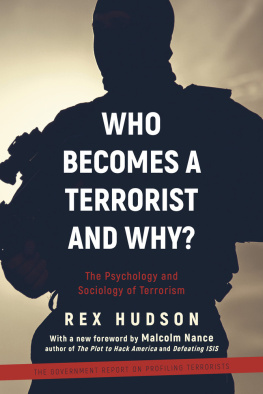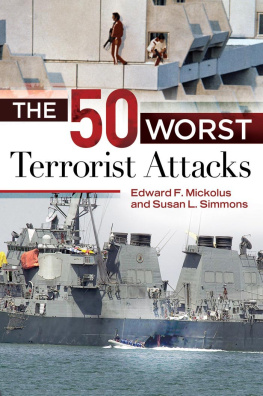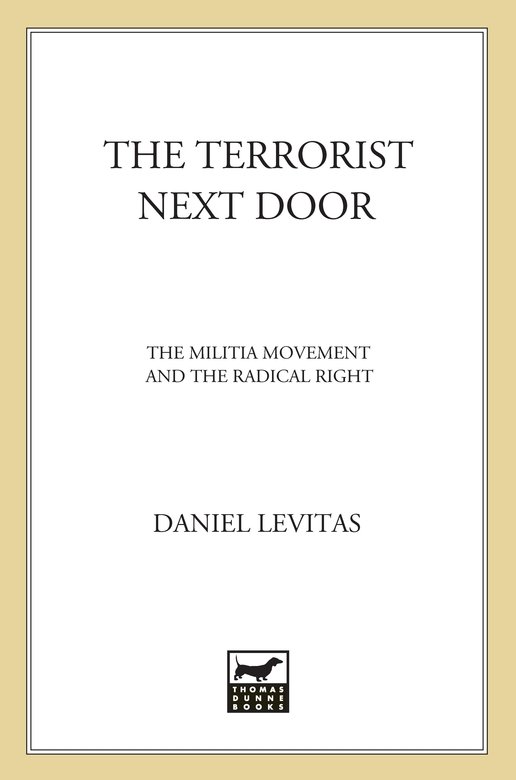I began work on this book shortly after the bombing of the Federal Building in Oklahoma City in 1995, and concluded in the wake of the tragedy of September 11, 2001. Although the perpetrators of both attacks lived a world apart, each was motivated by an ideology steeped in bigotry. Timothy McVeigh and Terry Nichols felt justified in murdering scores of fellow Americans in pursuit of their vision of a white, Christian, Constitutional Republic. The terrorists of Al Qaeda saw all Christians and Jews as infidels and enemies, obstacles to their goal of asserting radical fundamentalist Islam anywhere they wished.
While some people regard this countrys radical right as a fringe movement of brutish neer-do-wells incapable of threatening the values and institutions of democracy, I do not. Whether the victims of hate are counted one at a time, like Matthew Shepherd and James Byrd, or by the score, the cost is still immeasurable. In the larger sense, consider the damage done to the fabric of democracy by those who promote or silently sympathize with racism, anti-Semitism, gay bashing, hatred of Arabs and immigrants, or similarly bigoted beliefs. Of course, not everyone who has helped me with this book agrees with these assessments, or with the other conclusions and interpretations the reader will find here. But each person who contributed to this effort has my heartfelt thanks, because without their participation this book would be diminished.
I am especially indebted to my longtime friend and colleague Leonard Zeskindwho first urged menearly twenty years agoto more closely track the purveyors of hate in order to oppose them more effectively. I am also grateful to my friend and mentor Dave Ostendorf, who joined me in these efforts while we were working on the front lines of the farm crisis during the 1980s; and to those farmers, lawyers, rural advocates, and others who participated in many aspects of the fight to secure economic justice for farmers and defeat the rural radical right. They include: the courageous former North Dakota agriculture Commissioner, Sarah Vogel; Randi Roth, Jim Massey, Lynn Hayes, and the staff of the Farmers Legal Action Group; Barb Grabner, Mark Lundgren, and my colleagues at PrairieFire; Roger Allison, Steve Wandro, Merle Hansen, Carol Hodne, Joan Blundell, Denise OBrien, Gary Lamb, Mark Ritchie, Joe and Mary Jane Weisshaar, George Naylor, Dave Carter, the late Father Norm White, Tam Ormiston, the late Reverend Mac Charles Jones, Jonathan Levine, Rabbi A. James Rudin, David Goldstein, Carol Smith, and many others.
Although I started work on the manuscript in 1995, my agent, Ronald Goldfarb, had been encouraging me to write a book like this for several years. Had it not been for his persistent encouragement and able guidance, this project would still be nothing more than another item on my list of things to dosomeday. Likewise, I deeply appreciate the patience and faith of Thomas Dunne and Sean Desmond, my skillful and supportive editors at St. Martins Press. My appreciation also to Mark Fowler, for his advice and counsel, and to my copyed-itor whose precise and diligent hand has greatly improved both my writing and the text.
As a seven-year project, this book would have taken even longer to complete without the financial support I received from various individuals and foundations. I want to especially thank Lance Hill and the Southern Institute for Education and Research at Tulane University for their steadfast personal, institutional, and financial support. Thanks, also to: the Samuel Rubin Foundation, Daniel and Joanna S. Rose, Josephine G. Lindsley, Harriet Barlow and the Blue Mountain Center, Victor and Lorraine Honig and the Limantour Fund, the Lubo Fund, the Hall/Rubinstein Family Fund, and the EMSA Fund.
Any and all mistakes in this manuscript are my own, but it took many people to gather the voluminous material which documents the story I have attempted to tell. Among them are: my colleague Ken Stern at the American Jewish Committee and its always accommodating library staff, especially Cyma Horowitz and her able colleagues: Michele Anish, Charlotte Bonelli, and Steven Z. Koplin; Ken Toole and the staff of the Montana Human Rights Network; Devin Burghart and Justin Massa of the Center for New Community in Chicago; Mark Potok and the staff of the Intelligence Project of the Southern Poverty Law Center; Jonathan Mozzochi, Chuck Tanner and Steve Gardiner, all formerly of the Coalition for Human Dignity; Eric Ward; John Lunsford and Professor Barry Mehler of Ferris State University. Also to those individuals who cannot be namedand who took serious risks to penetrate the ranks of the radical right, deep thanks and admiration.
Numerous libraries and archivists have been equally indispensable to my research. Among them: Robert Marshall and Sharon Howe of the Urban Archives Center at California State University, Northridge, whose long-distance help unearthed a trove of terrific material from the files of the Community Relations Committee of the Jewish Federation Council of Los Angeles. In that connection, my warmest thanks go to the late Joseph Roos, who tracked and catalogued the escapades of Hitler sympathizers and other homegrown rightists for decades, beginning in the 1930s. I also wish to thank James Danky, newspapers and periodicals librarian for the State Historical Society of Wisconsin, and Sheryl Williams, Rebecca Schulte, and others on the staff of the Kansas Collection at the Spencer Library at the University of Kansas in Lawrence, which contains unparalleled material on the far right. Complementing this help have been legions of court clerks, administrative assistants, and others who took time away from more pressing tasks to help me find crucial files, documents, or microfilm records on unreasonably short notice. Karen Matthews, the clerk-recorder of Stanislaus County, California, who stood up to the threats of right-wing militants and paid dearly for her courage, helped me further by sharing her personal story.
I owe special thanks to the relatives and descendants of William Potter Gale, who generously shared their memories, thoughts, and reflections. This process was sometimes painful, occasionally humorous, but always revealing. They shared their ideas and reminiscences willingly and I have enormous respect for their honesty and self-disclosure. Time and again, I was heartened by the fact that Bill Gales bigotry did not survive him particularly well. As Gales son aptly put it, If anything, I learned the ill effects of prejudice from a unique perspective.
I am thankful, also, to those who helped me track down genealogical treasures and sort fact from fiction when it came to the riddles of Gale/Grabifker family lore: the late Amy Levinson worked indefatigably in Portland, Oregon; Harvey Kaplan did the same for me in Glasgow, Scotland.
Among those who provided photos, dug up useful facts and background material, or contributed in other ways were: Jenny Warburg, Walter Bell, and Jorge Jaramillo; Carrie Baker, who retrieved important legal documents and case law; Dorothy Dellar Kohanski, whose recollections of the hardships endured by many of the Jewish settlers at Painted Woods, North Dakota, were extremely helpful; Dan Yurman, who helped with last-minute fact-checking on the shenanigans of the Idaho militia and its allies; Fran Pici; and Bill Newnam.
After spending many years being interviewed by reporters and authors it was a pleasure to reverse roles. Among the journalists who shared materials and insights indispensable to my research was my friend and fellow author Jim Corcoran, whose book, Bitter Harvest , remains the definitive account of the life ofGordon Kahl. Thanks also to Scott North, Jim Ridgeway, Beth Hawkins, Dennis King, Bob Lange, Lorraine Jewett, Bruce Maxwell, Kevin Flynn, Gary Gerhardt, and others whose research and writing over the years helped me write this book.

